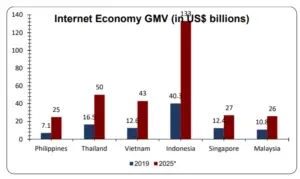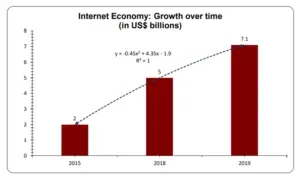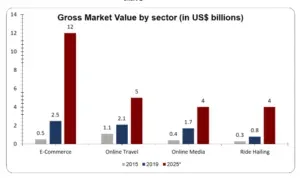Digitization is becoming the key to unlocking economic growth in the 21st century’s innovation era. Thus, Philippines’ performance in the global race for economic supremacy will be determined by its ability to foster innovation and develop digital capabilities. Tremendous progress has already been made in this regard, metrics of which are as follows:
Philippines’ internet penetration rate stood at 67% as of 2021, making it more digitized than other thriving emerging markets in South East Asia. As shown in chart 1, Philippines’ progress in this regard has outpaced economies like Thailand and Vietnam, but there is still a long road ahead as the country tries to catch up with the veteran economies of Singapore and Hong Kong. This might not take all that long considering the rapid rate at which the Filipino population is adopting the internet. As can be seen in chart 2, the country’s internet penetration rate increased from 6% to 60% in just the ten-year period starting 2007, and if this trend were to continue, Philippines would become an indomitable force in Asia’s digital economy.


Philippines’ internet economy amassed a Gross Market Value of US$ 7.5 billion in the year 2020. There are four segments to the internet economy:
Despite its substantial size, Philippines’ internet economy is the smallest among the six major economies of ASEAN. It is, however, expected to go through a tremendous phase of growth in the years to come, with experts at Google estimating the internet economy to more than triple in size by 2025. As exhibited in the graph below, Philippines’ internet economy is projected to hit a GMV of US$25 billion by the year 2025, thus making the country a cache of opportunity for foreign investors.

Philippines’ internet economy, though smaller than some of its peers’, has demonstrated remarkable growth in the last few years, with the GMV of the digital economy increasing by over 250% since 2015. This rapid growth, as depicted in chart 1 below, bodes well for the country’s future economic prospects in a largely digitized world. But it also leads us to ask, which segments have been the primary growth drivers of Philippines’ internet economy? Chart 2 helps us in answering this question by showcasing the GMV of each segment in Philippines’ internet economy. E-commerce has undoubtedly been the best performer in the country’s digital space, followed closely by Online Travel, and this trend is expected to persist till the year 2025.
Chart 1

Chart 2

Major players in the digital space– The tech start-up ecosystem in Philippines is yet to reach the level of success that has been achieved in leading ASEAN economies like Singapore and Indonesia. However, there are several promising young companies that are paving the way for increased innovation in the archipelago, and are, thus, inching the Philippines towards digital leadership. Some of the noteworthy technology start-ups in the Philippines are as follows:
To learn more about the digital economy in Philippines, click the link below:
https://www.blog.google/documents/47/SEA_Internet_Economy_Report_2019.pdf

Name – Voyager Innovations Industry space – Internet Marketing Business Outline – Voyager Innovations builds platforms for digital consumer engagement, marketing solutions, and digital financial services. From Internet Access to eCommerce, Digital Marketing to Fintech, Voyager has established industry leadership in inclusive innovations, allowing millions more to participate and be productive in the new digital society.

Name – Coins.ph Industry space – Fintech Business Outline – Founded in 2014 in the Philippines and serving over 10 million customers, Coins.ph provides consumers with direct access to banking and digital payment services, including local and international remittances, mobile airtime, bill payments, game credits, and online shopping.

Name – Paymongo Industry space – Fintech Business Outline – Founded in March of 2019, Paymongo is a fintech company which aims to simplify payments for modern businesses by providing easier ways for merchants to get payments online. Having received record-breaking seed funding in terms of “the amount raised for any start-up in the Philippines”, Paymongo recorded average weekly growth of 117% and a network of over 1,000 businesses as of September 2019.

Name – First Circle Industry space – Fintech Business Outline – First Circle was founded to empower Small and Medium Enterprises (SMEs) in growth markets by financing theirB2B trade transactions, thus, helping them grow by providing convenient access to financial services. Since its public launch in 2016, First Circle has grown to a point wherein it provides millions of dollars in financing to SMEs across various industries.